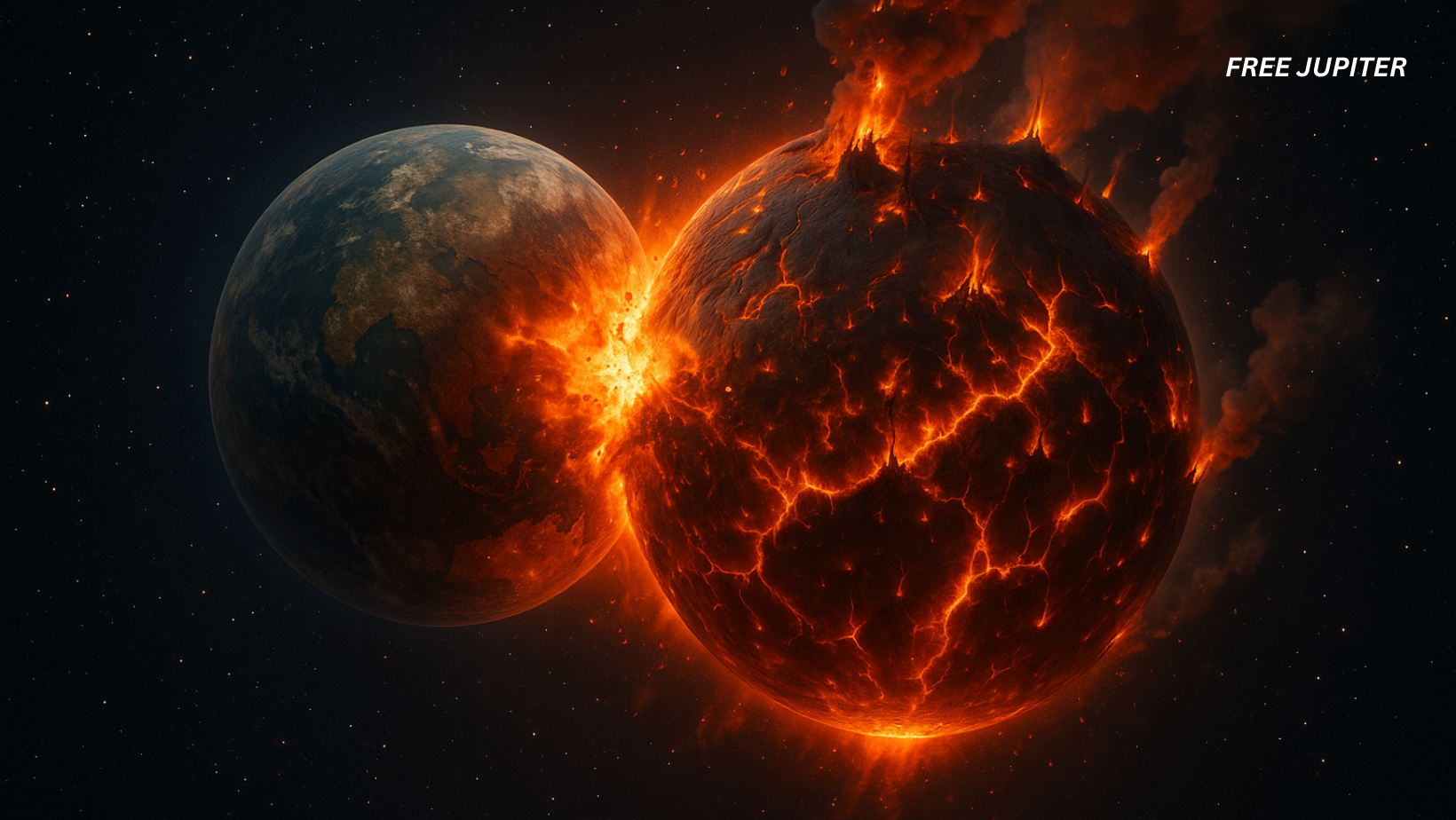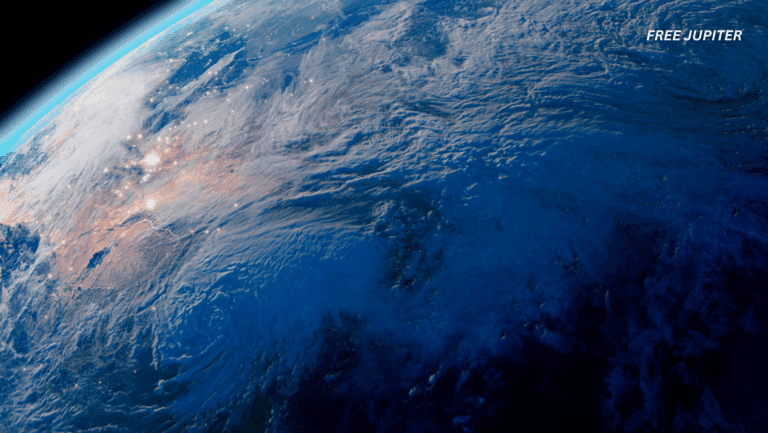The ground beneath your feet might not have always belonged to this Earth. At least, not the Earth we know today.
According to a growing number of scientists, our planet’s early years were far from peaceful. About 4.5 billion years ago, Earth—still just a young, unstable mass of rock—likely collided with another world about the size of Mars. Instead of obliterating both, the crash produced something new: the Earth we stand on today.
This isn’t just a tale of destruction. Some researchers now argue that without that colossal collision, life as we know it might never have appeared here at all.
A Dry, Hostile Earth?
A team from the University of Bern in Switzerland recently took a closer look at what the very first version of Earth—often called “proto-Earth”—might have been like. Their conclusion? Pretty bleak.
Because of its closeness to the Sun, proto-Earth would have been scorching hot. Any light, volatile elements—like hydrogen, carbon, or sulfur—would have quickly boiled off into space. Their analysis suggests this purge happened within the first 3 million years after Earth began forming.
In simpler terms: early Earth may have been dry, barren, and chemically stripped down. If it had stayed that way, our planet might have resembled something closer to Mercury—a sun-baked rock, rather than a blue-and-green oasis teeming with life.
Read more: Astronomers Suggest That Earth Is Sitting in the Middle of a Massive ‘Cosmic Void’
Enter Theia: The Planet That Saved the Day
This is where Theia comes in.
Theia is the name scientists give to the mysterious Mars-sized body that supposedly slammed into proto-Earth billions of years ago. The theory goes that Theia didn’t just smash into our planet; it actually merged with it. Some of Theia’s material may have even splashed out to form the Moon, which explains why Earth and the Moon share some uncanny chemical similarities.
But more importantly, Theia may have carried something proto-Earth desperately lacked: volatile elements. These include the building blocks of life, like water, carbon, and sulfur. If Theia had formed further out in the solar system—where icy, water-rich materials were abundant—then its crash landing could have delivered these precious ingredients straight into Earth’s crust.
In short, Earth may have started as a desert world but became habitable thanks to a lucky cosmic accident.
Radioactive Clues from the Past
But how do we know all this? After all, nobody was around to watch planets smash into each other billions of years ago.
The Swiss researchers relied on a clever trick: they measured the decay of radioactive isotopes. Specifically, they looked at manganese-53, which naturally turns into chromium-53 over time. By comparing the ratio of these isotopes in meteorites and Earth rocks, scientists can estimate when planets stopped “trading” material with their surroundings.
Their results suggest proto-Earth sealed off its chemistry just 3 million years after the solar system formed. That’s incredibly fast in cosmic terms. And since manganese—already a relatively stable element—was evaporating at that stage, it means even lighter, more fragile elements like hydrogen and sulfur would have been long gone.
Translation: proto-Earth was bone-dry. Any water or carbon we enjoy today almost certainly came from somewhere else.
Water Is Necessary—But Not Enough
Now, let’s be clear: water doesn’t equal life. Just because a planet has oceans doesn’t mean fish, forests, or humans will follow.
Take Europa, one of Jupiter’s moons. It has an ocean hidden beneath its icy shell, but no one knows whether life exists there. Or look at Venus, which may once have had oceans but is now a toxic pressure-cooker. Water is crucial, yes—but it’s more like a stage than the play itself.
Theia, in this case, provided the stage. By bringing in water and volatile chemicals, it created the conditions under which life could eventually emerge. The spark—the mysterious chain of chemical reactions that turned lifeless molecules into living cells—came later, and remains one of science’s greatest puzzles.
Read more: Quadruple Star System Found Surprisingly Close to Earth
Other Theories About Earth’s Water
Not everyone pins the origin of Earth’s water on Theia alone. Another popular theory suggests that icy comets and meteorites delivered water in countless smaller doses over millions of years. Imagine Earth being pelted by frozen delivery trucks from space, each one leaving a little more liquid behind.
In fact, some studies of carbonaceous chondrites—a type of water-rich meteorite—show they have a chemical fingerprint similar to Earth’s oceans. That hints at a bombardment scenario, rather than a single planet-sized delivery.
The truth could be a mix: Theia may have delivered a huge early supply, while comets and asteroids topped up Earth’s water levels later on.
A Quirky Reminder: Earth Got Lucky
What makes this story fascinating isn’t just the science—it’s the sheer improbability of it all. Out of billions of planets in the galaxy, ours may only be habitable because of a random crash. If Theia had missed proto-Earth, we might have ended up as a lifeless rock. If the impact had been too violent, Earth could have been torn apart entirely.
In other words, life exists here because the universe rolled the dice and, against all odds, landed on a winning number.
Related Tangents Worth Exploring
- 1. The Moon’s Role in Life on Earth – Interestingly, the Theia collision may have given us more than just water—it may also have created the Moon. And the Moon isn’t just a pretty nighttime ornament. Its gravitational pull stabilizes Earth’s tilt, which regulates our climate. Without it, Earth’s seasons could have swung wildly, making life far more difficult to sustain.
- 2. Exoplanets and the Hunt for Habitability – Astronomers are now looking at distant exoplanets, trying to figure out whether similar cosmic accidents shaped them. Could other worlds also have been enriched by collisions, turning sterile rocks into cradles for life? Every discovery of water-rich exoplanets adds a new layer to the story.
- 3. The Goldilocks Principle – The “collision theory” also ties into the broader Goldilocks principle: Earth isn’t too hot or too cold, too dry or too wet—it’s just right. That delicate balance might depend on lucky accidents like Theia. Which makes one wonder: how many other planets out there never got their lucky break?
Read more: Scientists Think They Have Pinpointed the True Origin of Life on Earth
The Takeaway
The Earth beneath us may not be the “original Earth” at all. Instead, it’s a hybrid—a cosmic mash-up born from a violent impact billions of years ago. And it may be that very collision, with a mysterious planet named Theia, that brought in the ingredients needed for life to eventually flourish.
So next time you look at the Moon, remember: you’re also looking at the aftermath of the crash that made us possible. Life on Earth owes its existence to a spectacular accident—a planetary fender-bender that rewrote the destiny of our world.
Featured image: Freepik.
Friendly Note: FreeJupiter.com shares general information for curious minds. Please fact-check all claims and double-check health info with a qualified professional. 🌱










